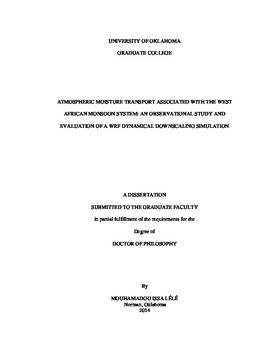| dc.description.abstract | The intraseasonal variability of the low-level atmospheric moisture transport and its divergence associated with the West African monsoon (WAM) has been investigated for the 1960-2008 period using the NCEP-NCAR reanalysis data. The climatology of the moisture flux integrated from the surface to 850 hPa, shows moderate southerly moisture transport prior to the WAM onset (March-April), associated with cross-equatorial flow in the South Atlantic Ocean and southwesterly flux exceeding 200 kg m-1 s-1 over the Guinea coast just after the WAM onset (May-June). On the intraseasonal time-scale, the study indicates that besides the transport/divergence by the mean flow, the transport/divergence by the intraseasonal climate (timescale >10 day) anomalies dominates the total atmospheric moisture transport over West Africa. There is also a relatively strong and uniform moisture transport by the synoptic (timescale <10 day) anomalies over the Guinean coast but its associated moisture divergence was relatively small. It is also shown that the zonal component is the largest contributor to the mean moisture transport into the Sahel while over the Guinean coast, the meridional transport contributes the most, and the prevailing strong westerly transport extends polward to 20oN. Large scale moisture flux convergence is suggested to be the primary source of water vapor needed to support enhanced convection over West Africa.
In the second part of the study, the active and break monsoon periods have been analyzed. Results showed that intraseasonal wet (dry) spells in the Sudan-Sahel region are the manifestations of the superposition of the 2-9, 10-25, and 30-90 day intraseasonal oscillation associated with enhanced (suppressed) moisture transport and convection. In general, wet (dry) spells over the Sudan-Sahel region are associated with dry (wet) spells over the Guinean coast. Lag regression between the intraseasonal wet/dry spell anomalies and 30-90 day filtered moisture transport/divergence anomalies shows that the 30-90 day timescale has a very large zonal scale encompassing both the Sudan and the Sahelian zone. The suppressed convection over West Africa leads to an increased surface temperature and surface pressure gradient. These effects act to further strengthen the monsoon winds and moisture transport towards the ITF, and increased convection in the continental Intertropical convergence zone. Strong and significant positive linear correlations (+0.59 to +0.89) are found between Sudan-Sahel July-September precipitation and moisture flux convergence of the intraseasonal moisture flux anomalies, while moderate positive correlations (+0.32 to +0.63) are found with that of the mean flow. These relationships indicate potential short term monsoon predictability which will be useful for agriculture.
Lastly, an attempt was made to evaluate the performance of convective parameterization scheme options for the Weather Research and Forecasting (WRF) model in simulating WAM features that occurred during August 2006. Skill score measures for six configurations indicated that no scheme was obviously best at all times in simulating WAM variability. The greatest variability in forecasts is found to come from changes in the choice of convective scheme, although notable impacts also occurred from changes in the microphysics schemes. Specifically, changes in convective schemes had the largest impact on the simulated rain rate, while simulations of total domain rainfall were influenced by choices of both the microphysics and convective schemes. However, the WRF model has been able to simulate reasonably well the gross pattern of many regional features, such as the magnitudes of the monthly accumulated precipitation, the low- and upper-level winds including the location of the AEJ, the monsoon depth, and the time and passage of westward propagating storms crossing the West African domain. | en_US |
